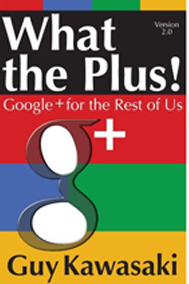 You may have read our book review of Enchantment by Guy Kawasaki, the guru of writing on Apple and author of many business best sellers. Kawasaki has been a leader in jumping on the social media bandwagon, having over half a million followers on Twitter, alone. Now, however, Kawasaki is enchanted with Google+ and has written an eBook that is minimal in cost with Kawasaki’s intention of being the evangelist for Google+ and convincing us of its benefits beyond any other social media outlet for personal and career use.
You may have read our book review of Enchantment by Guy Kawasaki, the guru of writing on Apple and author of many business best sellers. Kawasaki has been a leader in jumping on the social media bandwagon, having over half a million followers on Twitter, alone. Now, however, Kawasaki is enchanted with Google+ and has written an eBook that is minimal in cost with Kawasaki’s intention of being the evangelist for Google+ and convincing us of its benefits beyond any other social media outlet for personal and career use.
This concise eBook is filled with how-to information on optimizing your use of Google+, which can be confusing to the average Facebook user, since it has more to offer. Kawasaki is the ultimate evangelist, offering this inexpensive book (at $1) to tout his excitment for what Google+ has to offer. His prediction is that Google+ will far exceed Facebook and Twitter. “From my perspective,” he writes, “Google+ is to Facebook and Twitter what Mackintosh is to Windows,” which for him concludes that Google+ is better.
One of his primary reasons for extolling the virtues of Google+ is that Google “owns the playing field.” It owns one of the largest rivers of Internet traffic and search and can divert people to Google+ whenever it chooses.
Kawasaki describes various social media outlets and compares them to Google+. Twitter, he explains, is for real time perception, for immediate news and information. Facebook caters to what is going on in people’s lives. Pinterest is an online bulletin board for sharing ideas in pictures. And Google+? It’s for pursuing passions with people, even those you do not know.
As with other forms of social media, Google+ has its own terminology. You “circle” people, similar to “following” or “friending.” You can click on categories of people, a person’s profile and view how his or her posts are shared and by how many. Circling is more powerful than Facebook or Twitter, according to Kawasaki. You don’t have to send a friend request but can just add people to your circles. You can lock posts, so they are not shared and you can also share circles or add a circle for short term purposes.
There are seven buttons in the navigation of Google+. These include Home, Profile, Explore and Hangouts, which enables people to have a video chat session with up to 9 people. There is a Photos button and a Circling button for organizing and filtering how you interact with others. There is also a Pages button for linking to other pages. By the way, Kawasaki has diagrams for all of these buttons that offer detailed explanations on how to use them.
Kawasaki also feels that Google+ is good for business, because it offers the opportunity to maximize on social searches and be seen and heard. He explains in detail how to optimize your profile, how to post, and many other points from how to achieve trustworthiness to how to enhance the live conferencing (hangout) feature. This book is a quick read and a great reference, if you are interested in diving into the waters of Google+ or maybe just want to tread slowly. We will be including more of Kawasaki’s tips in our tech tip blog posts and tweets. Stay tuned.


